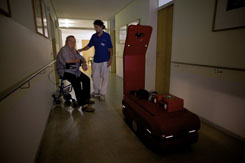Need-based Use of Robots in Inpatient Care Facilities
Service robotics does not only provide promising technologies for increased self-sufficiency and improved integration of older people. The use of service robots in inpatient elder care facilities also holds the potential to relieve nursing staff of routine, time-consuming tasks, thereby allowing them more time to interact with residents. To develop this new market over the long term and make coherent and complete solutions available to future users, stronger ties are needed between research and practice.
The aim of this collaboration was the need-based development and testing of new fields of application for service robotics in the context of inpatient care. As an overriding goal, the project additionally called for the establishment of a knowledge-transfer loop for interdisciplinary interaction and communication, extending from the developers of service robotics to the manufacturers and users.
First, to determine appropriate operational scenarios, a needs analysis was conducted to identify highly time-consuming routine nursing activities which do not involve direct patient contact. These were compared with the abilities of the available robots – the Fraunhofer IPA’s “Care-O-bot®“ 3 and the “CASERO®“, developed by MLR Systems GmbH. The operational scenarios for the service robots were then further elaborated, discussed with the involved users (especially nursing staff), and optimized through multiple iterations. After the implementation in the robots, the developed solutions were tested in two one-week practical evaluations in an elder care facility.
The application field of “CASERO®“ encompassed the performance of regular services, e. g., removing dirty laundry and supporting nursing staff during the night shift. The tasks of the “Care-O-bot®“ included bringing beverages to the residents and functioning as an entertainment platform.
The practical evaluations demonstrated that certain operational scenarios for service robots in inpatient care facilities can already be technically implemented. Additionally, both the benefit of the service robots to nursing staff and their acceptance among all involved groups were verified.
 Fraunhofer-Gesellschaft
Fraunhofer-Gesellschaft




